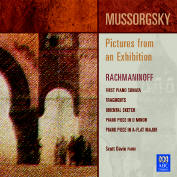Australian pianist Scott Davie specializes in Russian music and is something of a scholar. He devotes portions of his booklet notes to the proper English translation of Mussorgsky’s major piano opus (that’s why the pictures are “from” an exhibition here, as opposed to “at” an exhibition everywhere else) and to the correct English spelling of Sergei’s last name (“Rachmaninoff” or “Rachmaninov?”). It appears that propriety also dominates Davie’s pianism, which is straightforward, true to the composer’s text, and rather sober. If Davie doesn’t maul Mussorgsky’s Pictures with affetuoso graffiti, neither does he provide the suppleness and scintillation we expect in faster movements nor conjure up spooky sonorities in Bydlo, Baba Yaga, or the Great Gate at Kiev.
Likewise, Davie delivers a clean, conscientious performance of Rachmaninov’s rambling, orchestrally oriented First Sonata. My main reservation concerns the pianist’s limited dynamic range and his gingerly approach to the composer’s frequent fortissimos. Granted, Davie loosens his inhibitions in the third movement, even if he ultimately yields to Alexis Weissenberg’s razor-sharp articulation, thundering accents, and galvanizing momentum (true, Weissenberg disregards most of Rachmaninov’s dynamic indications, yet does so with fierce authority!). Davie concludes the program with his effective reconstruction of an essentially complete two-page sketch he discovered while poring through Rachmaninov’s papers at the Library of Congress. It’s a chord-based piece that ventures into unpredictable harmonic territory, and holds more than mere curiosity value.
































